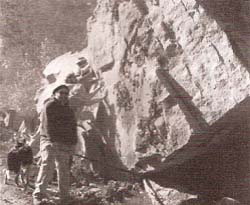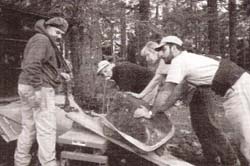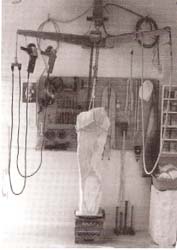- Details
-
Created: Thursday, 02 November 2000 05:52
My eyes were bleary from train-lag. I had been in Europe for two weeks already, sliding the slopes of the Alps, taking in the tourist sights of Paris, with a short weekend hop to visit friends in Cologne. But the overnight train from Germany to Italy had not been as restful as I wanted. I had enjoyed the ride immensely as Florian, my German cabin-mate, and I talked late into the night about his journalist job and life transitions. I fell asleep writing in my journal about my transition from workaholic to unemployed traveler.
In Milan I changed trains to find that, while I had a ticket, I didn’t have a seat. I had refused to buy a seat when the Italian conductor told me I needed one, convinced he was trying to shake me down. On the first stop out of Milan I was booted from my seat by the rightful ticketholder and ended up standing for the balance of the 4-hour ride to Florence. I really wanted to sleep instead.

In Florence I changed trains again to head northwest. One hour later I disembarked in Viareggio. From there I grabbed a cab for the small town of Pietrasanta, about 15 minutes north along the coast. I had made the uniquely American assumption that Pietrasanta was a small town and therefore would not be served by public transportation. The cab let me off at my hotel in Pietrasanta, 100 feet from the train station.
Though I was tired, I followed the rule of not setting your suitcase down in the hotel lobby before inquiring about the rate, and trying to appear as though I could just as easily go elsewhere (while hiding my fear that I didn’t know where else I could go). The room was good and the rate expected, so I snuggled in.
After this mid-day catnap I wandered town to get a feel for my new home. It was a classic Tuscan town, complete with town walls, a piazza, olive groves on the hillsides above, and the constant buzz of motor scooters. I walked past the door to my future studio four times, not because I didn’t see it but precisely because I did. It was intimidating, a studio likely full of professional sculptors who would laugh at my amateur attempts. The door was solid with no windows, the only glass being 10 feet above street level. I wanted to press my nose against that glass to assure myself this was a friendly place. Scaling the wall was out of the question though, as I visualized the process of trying to explain myself to the police and the studio owners. After eating a second lunch, to delay the inevitable and provide blood sugar fortification, I knocked on that door. Silver io Paoli welcomed me with that particular Italian flair that made me feel stupid for fearing. I got a tour of the space, met the other sculptors who were there, met son Marco, and then shared the obligatory drink in Silverio’s upstairs apartment. Studio rent was set at $230 per month, which included air, power, carving tables and negotiated use of tools. I was to return the next morning to start sculpting.
The next day was a blur of getting myself set up, talking with my new studio mates and taking in all the stone that surrounded every bit of life in the Apuane Alps. Silverio took me to a real estate agency to find an apartment. While waiting he tried to charm a pretty Brazilian girl on my behalf “You looking-a for apartamento too? You can-a share-a weeth Ken-a?” She didn’t bite. When the agent returned 30 minutes later than his sign said (get used to it Ken… better than 90 minutes late), he indicated no availabilities. I returned, discouraged, to the studio. At least I would get a little carving done for the day while I considered my next move. Joy, my main studio mate and soon a close friend, didn’t talk to me. Evidently I was working the stone so intensely she was afraid I would bite her head off if she wandered close.
The second studio day Joy discovered I could relax and invited me to a lunch of ex-pat artists (“chicken day” is a Pietrasanta institution, where some artists bring cooked chickens and everyone else brings bread, wine, salad, cheese, etc.). There I met most of the local artists and found out about an apartment that would be coming available. I was confused as it was handled by the same real estate agent. I returned to his office with the exact address I
wanted to see. I was notthrilled with the place but thought I would have no choice. Then he mentioned several other places that I might want to see to compare. Perhaps I saw his evil twin the day before? I ultimately selected a two-bedroom flat outside of town. It would be a 2 kilometer walk, but was pleasant and furnished. I negotiated a rent of about $430 monthly (which would have been $1,000 if I were there in July/August).
At first the two-kilometer walk drove me crazy, as did the work schedule of my studio. I wanted to run to town to minimize the unproductive transit time. The studio opened at 8am, closed at noon for lunch, reopened at 1pm, then closed again at 5. Weekend work was out of the question, as was any extension of the hours. How could anyone possibly hope to get any work done with these hours? April is also rich in Italian holidays, all of which were observed by my studio. Ultimately I came to relish the walk, the fields, the dogs behind stucco walls, the rosemary bushes, the view of the marble-white mountain tops, the fireflies. And I relaxed about “producing”. I vowed to learn, to carve in the moment, and to leave all my work in Italy. I did not want any pressure to “produce”, to create works that had value beyond my education. It was hard to absorb the full experience of Italy if I were tied to my studio from 8 to noon, 1 to 5. And the presence of\ huge piles of stone had an unanticipated effect. Stone, while still making me drool, was no longer so precious. So what if I ruined a piece? At such a cheap price I no longer worried about the material, other than how it reacted to my chisels and blades. I learned to relax with the stone.
My daily schedule evolved into breakfast at home, perhaps a cappucino at Bar Michelangelo, carving for a bit, a shopping trip to one of the tool stores or stone yards, lunch at Bar Iris, a gelato, more carving, more gelato, carving, a gelato, shopping at the market or grocery store, then the walk home. After dinner at home I would either draw ideas for more pieces, read, or more frequently walk back to town to the internet café. I was a regular, and used Yahoo mail to correspond with friends and Adele, a woman I had met skiing the week before I left for Europe (now my wife). Deviations from this schedule included an Italian tutor twice weekly in the morning, American movies with Italian subtitles at the theatre in town some evenings, and heated dinner discussions of whether there was any “valid” style of sculpting besides realistic figurative. Despite the gelatos, the daily wine, and the heaps of great Italian bread dipped in olive oil, I lost w eight in Italy. I suspect it was being on my feet all the time, walking to and from home one to three times a day and carving. I might have lost even more weight had I been there in mid-summer, when it can get quite hot.
The best weather for carving outside is mid-April to May and again mid-October to November. Many of the sculpting courses I have seen offered in Pietrasanta are held in August. If that is the only time you can go then do it. But I would have melted away in August, and the cost of housing, restaurants, rental cars and everything else is priced at a premium due to the proximity of the beach. Except for July and August, I could have easily lived and carved in Pietrasanta for $2,000 monthly, including the stone to work during that time. Bringing back stone or tools is obviously extra.
The studio was a decent enough place to work. If we were working a piece by hand (or with pneumatic tools) we could carve in the garden. There were enough air lines and covered spots to carve through all but the hardest downpours. A neighbor’s condo overlooked the garden so we could not grind there. Grinding was done inside and was generally unpleasant. Dust hung heavy in the air, there was not enough lighting, and we shared a compressed air line
when not electric grinding. Carvers in the other main transient studio in town were all housed in a single, much smaller room, so there was tremendous peer pressure to keep the dust to a minimum at that studio.
I had brought an Alpha blade with me, along with my air hammer and some chisels. Of course a Cuturi worked in Italy, but my American Alpha blade was useless on the European threaded grinder. I bought a European blade for my grinding/cutting and borrowed an angle grinder from Marco. Joy had to buy her own angle grinder (an Italian male vs. American woman thing?). I enjoyed the trips to the tool stores in town. Most of the tools were about half the price compared to the US. I brought back a couple dozen chisels plus a few other miscellaneous small tools.
While there were two main transient studios in town serving the ex-pat carver, there are also other studios where a visiting carver could rent space. One is a co-operative where perhaps 10 full-time carvers share space and resources. These carvers are often on the road or back in their home countries and will rent out their space. You must know someone or get lucky to find space there. John Fisher, an ex-pat carver, has a studio in the next town northwest. This studio is more suited to experienced carvers and frequently has space available by the month. I would enjoy the professionalism of this studio, though I w ould really miss being in the midst of a medieval town, the tool stores next door, and the gelateria. For the workaholic carvers, the Fisher studio is open 24/7.
Perhaps next time I would base my decision upon my carving style and the tools I like to use. I’ll talk more about that in Part Two in the next issue of the Newsletter.
- Details
-
Created: Thursday, 02 November 2000 05:48
On Saturday, October 7, our granite group piled into cars with prybars, gloves, heavy boots, hand dolleys, an electric winch and lunch, to rescue forgotten river boulders from their cavities on the shore of mountain streams. We had selected the finest day of the fall to do this. We wanted to avoid both rain and breaking a sweat.
The first stop for the five of us (Brian Berman, Sharon Feeney, Sabah Al-Dhaher, Sondra Shira and myself) was Tinkum Road, to explore the road fords of Rock Creek and Harris Creek. But these spots were far too convenient. The stones were at road level and close to the vehicles. Why bother? Might as well buy them from a vendor. We were out for grunts.
So we hurried back to North Bend and the 15 mile trip on washboard roads to the Taylor River branch of the Middle Fork of the Snoqualmie River. Here we found our quarry in abundance. We had our choice of fresh rocks being sculpted by the water as we watched, or of historic flood stones now rooted in the forest. We hand-hauled some smaller stones from the riverbed, but focused most of our grunting on the moss-covered flood stones. We got a good load without damage to any extremities, then headed back along the road. There had been a significant rock fall at a major outcrop right along the road, which we could not ignore. We stationed Brian as flagger for cars coming around the bend and backed Sabah’s stone mobile to a naked lady masquerading as a hunk of granite.Ten minutes later Sabah had winched the lady in to the stone-mobile and we were headed back to the city.

For others following in our footsteps, be sure to inquire about permits with the Forest Service. They did not require us to get one (mention the word sculpture and you get all sorts of breaks) but they are not always so inclined.





